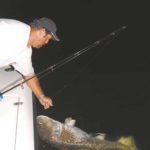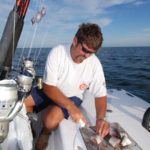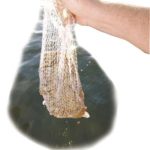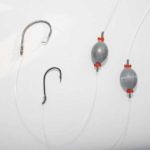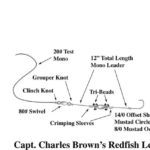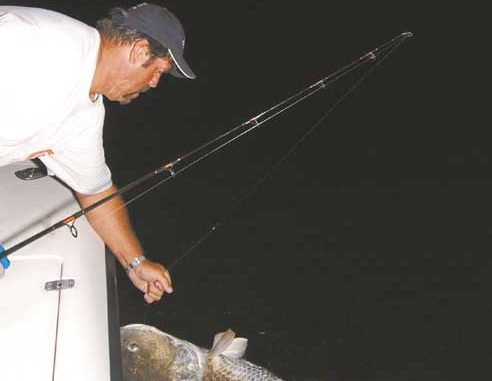
A veteran guide believes somewhere at Cedar Island swims an “old” red drum that will top 94 pounds.
The Cedar-Island-to-Ocracoke ferry was discharging a load of passengers late in the afternoon. The August heat was starting to dissipate in the slanting rays of the sun.A pickup truck backed a boat trailer to the water along the ramp leading from the gravel parking lot of the WRC’s Cedar Island Boating Access Area near the ferry landing and out jumped a giant of a man. Launching his center-console boat, he tied it off to the dock and parked his vehicle. Re-boarding the boat, he positioned several matched, out-sized spinning rods in the rocket launcher at the back of the boat’s leaning post.
The big man was Capt. Charles Brown, a fourth-generation Cedar Island guide. His family always has earned a living by guiding hunters and fishermen to the best outdoor opportunities offered at the last vestige of the mainland.
The road ends at Cedar Island, but the water’s edge marks the beginning of Pamlico Sound and the best coastal fishing in the state for giant red drum.
“The old drum have been biting hard,” Brown said. “We should have a good night of fishing in store.”
Brown said the weather forecast called for a calm wind, a prerequisite for comfortable fishing.
“The sound is subject to a wind tide,” he said. “The wind can blow the water to the other side of the sound if it’s strong. It also makes the water too rough to fish. The best wind to fish out of Cedar Island is a south wind. Northeast winds can make the water too rough.”
Brown headed out at dusk, following channels marked by navigation lights. He passed across shallow sand bars and shoals and negotiated the breaks left by commercial fishermen inside the walls of their pound nets, which covered the sound in all directions. Eventually, he slowed, watching his depth-finder as he idled along.
“The drum concentrate at the drop-offs,” he said. “In this particular spot, there’s a drop from more than 14-feet down to 4 feet. The drum follow bait along the drop-off. Usually, they’re on the deep side. But sometimes they’re on the slope or on top of the shoal. I anchor where I can spread my baits to cover all the possibilities.”
Some of the places Brown fishes for the adult red drum of Pamlico Sound include the Old Harker’s Island Channel, Kingfish Light and former navigation channels that are no longer marked in the vicinity of the markers. Eventually, he selected a fishing place where there was a bend in the channel, anchoring in 12 ½ feet of water and casting back toward a shoal that was between 5- and 7-feet deep.
His reasoning was simple and irrefutable.
“This is where I caught them last night,” he said. “There’s still bait here, so the adult drum will still be here.”
Brown fishes from a 24-foot Venture boat with a 250-horsepower Suzuki four-stroke engine. He said a large center-console boat was the minimum requirement for anyone venturing onto the sound.
“In summer a thunderstorm can spring up at any time,” he said. “The wind can form squalls, and you have to be able to pick up and make it back to safety fast.”
Brown fishes Okuma Coronado 65 reels or Okuma Epixor FB 64 reels. Both reels have a bait-feeding feature. The rods are Okuma 7-foot, 10- to 14-pound class Tail Walker rods he spools with 20-pound monofilament.
“You need a rod with some backbone to fight a big drum,” he said. “The world record was a 94-pounder, and I don’t doubt that there are bigger fish than that swimming right here.
“These are the same fish that migrate to Hatteras in the fall. They come into the sound to spawn in July and August and around the time of the full moons in each month is the best time to catch them.
“They bite every night, but you can catch them in the daytime too. But typically, you’ll land the most fish from right at dusk to a few hours after dusk.”
Another reason for fishing at night is to beat the heat. The sound can be unbearable under a full sun. But once the sun goes down, the air temperature usually is quite pleasant.
Brown’s terminal rig consisted of a 12-inch length of 100-pound monofilament with a 3-ounce egg sinker pegged in place midway of the leader between two crimping sleeves with plastic tri-beads between the crimps and the sinker. At one end of the leader was an swivel and at the other, a 14/0 Mustad circle hook.
“It’s the Owen Lupton rig,” he said. “The short leader with the pegged weight makes it almost impossible to gut hook a big red drum. He picks up the bait and the sinker pulls the circle hook into the corner of his mouth.
“You fish with the rod in the holder and when the fish picks up the bait, he hooks himself. All you have to do is hang in there until he gets tired.”
Brown anchored the boat and hauled a trio of large striped mullet from an ice chest. He said he catches the baitfish by using a cast net, but sometimes buys them from local sources. He said he uses a product called Bionic Brine to soak them. It toughens the fish and keeps natural oils locked into the bait.
“There’s nothing like a big mullet to catch a big drum,” he said. “I slice them into three big chunks. I hook them from the inside out, so the hook point protrudes well beyond the skin of the dorsal side of the bait. I don’t use the head and the tail. I toss those overboard to act as chum or put them in the chum bag.”
Brown used frozen ground chum to create a scent trail behind the boat. The slight wind created a wind current, carrying the slick made at the surface by the fish oil for hundreds of yards. Soon, schools of baitfish were feeding in the slick. Brown cast four lines, two set off the back corner rod-holders and two on either side of the center console at an angle to the back of the boat. They created what Brown called a “fan” pattern.
“All sorts of fish are attracted to the chum,” he said. “The croakers bounce the bait and eat it and cow-nosed rays hook up and give you some excitement. But when the little fish and the rays stop biting, you’d better watch out because old big boy has moved in to eat the baits.”
Brown checked the reel drags by hand. He judged them to be set at 5 to 6 pounds of tension. He switched the bait-feeding features of the reels off so the fish could run with the baits.
He said it was important to set the lines from the console rods at a rearward angle to the boat because they were set parallel to the surface of the water. He also said it was important to be sure the bait-feeding features were operable.
“I’ve had rods set straight out from the console with the bails flipped the wrong way and a big fish comes along and pulls the rod out of the holder,” he said. “It happens so fast, you can’t react. The rod just flies off like a torpedo, and she’s gone.”
Soon, schools of menhaden were flipping at the surface. After the sun went down, the sound of the baitfish continued. Added to the gentle slap of waves against the hull, it created soothing fisherman’s symphony.
Then a reel went off.
“It sounds like a ray,” Brown said. “He went off a ways, then just stopped on the bottom.”
A few minutes later, a cow-nosed ray was at the edge of the boat. Brown de-hooked the “pancake tarpon” and let it swim away.
“They aren’t as dangerous as a stingray because their stinger is close to the base of the tail,” he said. “But you still have to be careful with them. They are big and strong, and they do have poisonous stingers. You’re going to catch your share of them if you go drum fishing.”
Small pinfish and croakers kept eating the baits. Brown constantly reeled in lines to check the bait. He said at least 25 pounds of mullet were needed for a night of fishing.
But sure enough, a rod bent and the bait feeder sang out. A big red drum took of with a chunk of mullet and the circle hook rotated into position.
“There he is!” Brown said with a shout. “It’s a nice one.”
He pried the rod from the console holder and shot the tip toward the stars, only to have it bent toward the water again. After a 15-minute battle, the fish was beside the boat. We took measurements of the fish, inserted a NCDMF tag below the dorsal fin, took a few photos and sent the fish on its way.
“It’s only 54 inches long and weighs about 55 pounds,” Brown said. “That’s just a little one. We should catch seven to 10 tonight.”
Another angler who fishes for giant red drum is Capt. Gary Dubiel of Speck Fever Guide Service. But he likes to fish for them in the daytime.
“You’re fishing the same drops as they do at night,” Dubiel said. “At night you anchor in the holes and cast to the shallower water. But in the morning, the fish move back to the deep side of the drops. You can anchor in the same spots. In fact, if you’ve been fishing all night, all you have to do is move your baits to the deeper water to stay on the same fish.”
Dubiel said the fish move to the deepest parts of the sound as the day progresses. He finds the fish in water as deep as 14 to 18 feet. But he said the drops that typically hold fish may be on smaller drop-offs and anything with a drop to 8 to 12 feet was worth investigating.
“They can be anywhere in the Neuse River, from Dawson’s Creek all the way to the mouth at Point of Marsh,” he said. “There’s always a pile of boats around Swan Island.”
The best bet is watching for visible signs of fish. He said slicks, pods of baitfish and even the big drum themselves may be visible.
“If you fish a certain spot and don’t catch anything within an hour, you’d better be moving someplace else,” he said. “You’re going to see bait everywhere, and there’ll also be red drum everywhere you see the bait. A northeast wind will blow the fish into shallower water because they like rough water. But on calm days, if you pick a good spot and wait they will come to you.”
Like Brown, Dubiel prefers fresh mullet chunks for red drum bait. He said he also brings 25 pounds of mullet along during a red drum trip.
“Don’t be shy about the bait supply,” he said. “Bait stealers are going to come and eat it, so I take 25 pounds of mullet along for a five-hour trip.”
Dubiel uses the Owen Lupton rig for protecting big fish against deep hooking. He also uses heavy spinning rigs for landing “old” reds.
A red drum can live 50 years and spawn annually after reaching an age of 4 years. It’s vital to restoring the fishery to allow every adult red drum to live to a ripe old age.
Using adequate rods and reels to avoid overtaxing the fish and the use of the Owen Lupton terminal rig are keys to the future of this fantastic fishing. Pamlico Sound and the Neuse River are the only areas of the state where adult red drum are proven to spawn and it’s the spawning concentrations that anglers catch in August.
“I use a Shakespeare Ugly Stik 7-foot rod with a Diawa BG 90 or Penn 750 or 850 spinning reel spooled with 25-pound mono and a 50-pound shock leader,” Dubiel said.
“A rig like that sounds big until you have to fight a big red drum. It will take you 10 or 15 minutes to land the fish. You get plenty of action, and the fight is still over fast enough it doesn’t overly tire the fish.”

